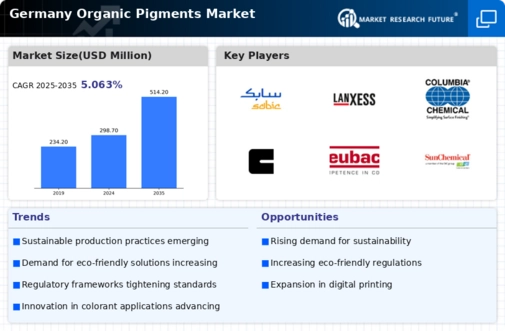The Germany Organic Pigments Market is characterized by a diverse and competitive landscape, comprising several key players that drive innovation, sustainability, and quality in pigment manufacturing. This market has gained significant traction due to the increasing demand for eco-friendly solutions across various industries, such as coatings, plastics, inks, and textiles. Companies in this segment are focusing on developing unique product formulations and enhancing their production processes to meet stringent regulatory standards and consumer expectations. Competitive insights in this market reveal a focus on research and development initiatives aimed at creating new organic pigments that offer superior performance and environmental benefits.
Additionally, strategic collaborations, partnerships, and expansions are common among players to establish a stronger foothold in this ever-evolving market.SABIC stands out in the Germany Organic Pigments Market with its well-established presence and strong reputation for high-quality products. The company's extensive portfolio of organic pigments is designed to meet the diverse needs of various industries, emphasizing performance, stability, and environmental compliance. SABIC leverages its technological expertise and innovation capabilities to create customized solutions that cater specifically to customer requirements in Germany. This strategic focus has enabled SABIC to solidify its position as a reliable supplier in the organic pigments sector.
Furthermore, the company's commitment to sustainability and responsible production practices resonates with the growing trend towards eco-friendly products in the market, enhancing its appeal to environmentally conscious consumers and businesses alike.Ferro Corporation has established a notable presence in the Germany Organic Pigments Market through its robust product offerings and innovative solutions tailored to customer needs. The company specializes in providing a range of organic pigments used in various applications, such as coatings, plastics, and construction materials.
Ferro Corporation's strengths lie in its commitment to quality and performance, supported by a strong research and development framework that enables the continuous introduction of new products. The company has also engaged in strategic mergers and acquisitions to enhance its market position and expand its capabilities within the region. These efforts, combined with Ferro's focus on sustainability and eco-friendly initiatives, have strengthened its reputation as a leading supplier in Germany's organic pigments sector, facilitating growth and capturing market opportunities in this dynamic marketplace.



















Leave a Comment